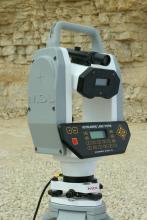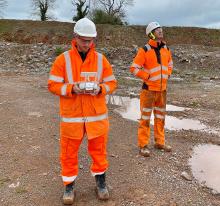
Drilling and blasting is one of the first operations to be carried out in a quarry to gain the material for further processing.
The vital process often starts with a detailed survey of the quarry face, which will enable the explosives engineer to design the blast and to plot where the shot holes should be drilled, enabling the task to be carried out safely and efficiently.
The EPC Groupe says it is among those continuing to develop energetic solutions for safe and efficient quarry blasting.
As quarry operations are essentially a process of converting solid rock into smaller particles of a desired fragmentation distribution, this comminution process is essentially achieved by the application of energy in one form or another, say Ricardo Chavez,
“In the blasting part of this process, the chemical energy in the explosive is used to both fragment and displace the rock. The use of too much energy gives increased fines, high air overpressure and a risk of flyrock. The use of too little energy leads to poor fragmentation, high vibration and poor digability,” they say.
“For each blast there is a design which has the perfect energy balance giving a safe blast with both the desired fragmentation and minimum environmental impact. Achieving this balance is a blast optimisation process involving close control over blast design, explosive and detonator performance and detailed performance monitoring.”
EPC-Groupe says it has carried out much research and development over the years looking at this optimisation process and has developed techniques and software tools to assist with the essential task of concentrating the available energy.
Constant energy techniques
“It is now common practice in the quarrying industry and standard practice within EPC’s drilling and blasting operations, for all quarry faces to be profiled using scanning lasers and all blast holes to be surveyed with in-hole probes. The use of such techniques gives greatly enhanced opportunities for blast optimisation by attempting to match the energy in the explosive to the exact amount of rock to be blasted on a hole-by-hole basis. EPC Groupe has developed blast design software, Expertir, to both process such survey data and to assist in the process of matching the explosive energy to the actual burden. The software includes a calculation that takes into account the additional energy required at the toe of the blast. In various studies this procedure has been shown to result in a much better energy balanced blast. In this case the variation of explosive energy is achieved by changing the type of explosive employed in the hole. The downside of this approach is that holes may have several different types of explosive resulting in very complicated hole loading designs that can be difficult to implement.”
Bulk emulsion technology
Site-mixed bulk emulsion explosives have been used in the European quarrying industry since the early 1990s and have become well established as the explosive of choice in many operations and are said to have a number of advantages over conventional explosives, especially in relation to safety.
“When it comes to blast optimisation such systems have a disadvantage in that only one type of explosive can be loaded in any one blast. This means that, in general, a compromise has to be made relating to energy distribution in the blast hole with the energy at the toe being optimised which results in the energy concentration in the upper part of the face being too high. To overcome this problem EPC Groupe has used aluminised bulk emulsion in the lower portion of blast holes but has now focussed its R & D efforts on developing variable density (variable energy) bulk emulsion technology.
“This development means that the density can be varied as a blast hole is being loaded thus giving variable energy up the column. For all new EPC variable density trucks it is therefore possible to match the explosive energy to the requirements of each part of each hole in a blast with the bespoke hole loading designs being transferred electronically directly from the blast design software to the bulk emulsion truck.”
Carbon footprinting
EPC Groupe has been a partner in the
The company has concentrated on the drilling and blasting part of this work with other partners working on the downstream aspects.
“As a result of working on this project EPC has now been able to develop a carbon footprint module to go with the blast design software Expertir. This EE-Blasting module requires detailed information on the blast design as well as basic information on distances between the quarry and the closest depot; between the depot and the factory; on the types of trucks used for transport; on the drill rigs used on the quarry, and on the average drilling speed.
“This module and the calculation methodology behind it provide pertinent information on the energy efficiency of the drilling and blasting operation. Comparisons can now be made between different patterns and/or designs, and try to optimise their environmental and energetic impacts.
The software deals with the environmental impact of the drilling and blasting operation and it is important to note that in any study of the environmental impact of a quarry operation this must be combined with data that also takes into account the footprint of the other parts of the process such as load haul, crushing and secondary processing.
“This ‘holistic’ approach allows a proper balance to be struck between the relative environmental impacts of all parts of the communition process.”
The next step
“As outlined, the technology now exists to be able to accurately measure the confinement on each part of each hole in a blast and to load variable energy explosives in the hole to suit that confinement. In addition the carbon footprint of each blast can be reasonably estimated,” say Chavez and Farnfield.
“Clearly a highly competent rock will require more energy to blast than a weak or broken rock and the reliable collection of such data is the missing link in our blast design process.
“Drilling equipment is now becoming available that can be equipped with the so-called ‘measure-while-drilling’ technology thus giving a record of various rock parameters for each hole in a blast. We can therefore look forward to the day in the near future that it will be possible to automatically adjust the explosive energy to not only match the confinement of the hole but also the competence of the rock.”
Quarryman Pro
The system, which also helps to improve safety, is said to have been an essential on-site system for quarries for over 20 years.
The original Quarryman, and later models, “transformed safety on site and enabled forward-thinking quarry managers to simply and swiftly modify processes, to decrease post-blast workflow and costs.”
Martin Carr, business manager, mining systems, says: “Customers using the new Quarryman Pro alongside Renishaw’s Boretrak system to optimise blasting will see a significant competitive advantage: quite simply, they will access accurate data more quickly, in a wider range of conditions, and be more easily able to export data to other mining software packages.
The new Renishaw Quarryman Pro is said to be optimised for speed of operation in tough environments, with swift setup, programming, scanning and data processing, and offers significant benefits over previous models, says the company.









